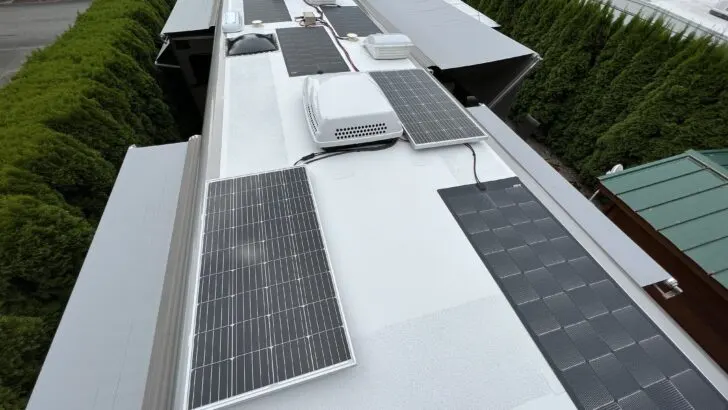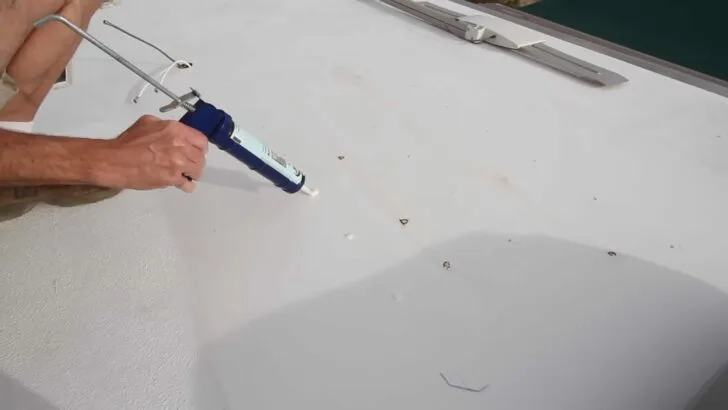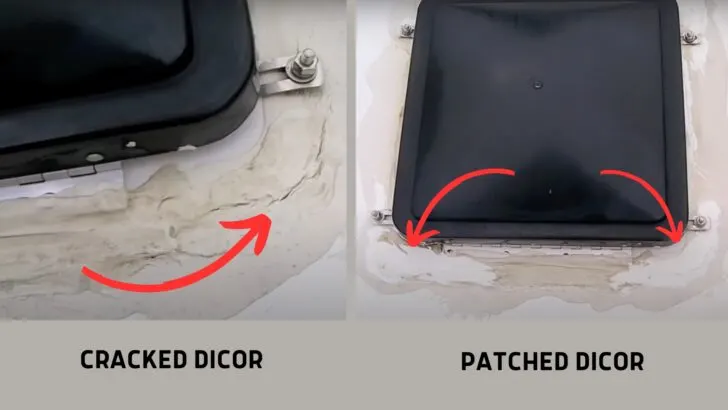We’ve previously talked about the popular RV rubber roof materials EPDM and TPO, and the latest rubberized RV roofing entrant — the PVC RV roof. Today’s post is an RV rubber roof showdown: PVC vs TPO vs EPDM RV roofs – which is the best choice of the three and why?
Common RV Roofing Materials
There are several different types of roofing material that are most commonly used on RVs. All seal out the weather and provide durability and UV-resistance which are important qualities for an RV roof. But each differs in certain ways, and each has its pros and cons.
The Fiberglass Roof
Many people consider fiberglass RV roofs to be the best choice of all RV roofing options. While it does have considerable benefits, fiberglass isn’t perfect, with some disadvantages as well.
Pros
Fiberglass is a great RV roofing material due to its durability and rigidity, lack of seams, low maintenance requirements, and sound-deadening qualities. Unlike flexible roof membranes, tearing of the material isn’t a concern. It’s even difficult to scratch fiberglass since the color is embedded right into the gel coat as an integral part of the fiberglass.
No fabric means no tears, and no paint means nothing to scratch off. With the roof being the most likely part of the RV to scrape low-hanging branches in the campground, a fiberglass roof is pretty much impervious to all but the most severe impact.

A fiberglass roof, like this one on our Mountain Aire, is super durable, with the color embedded right into the gel coat. Scraping under some low-hanging branches in the campground is generally no problem with a fiberglass roof (within reason, of course… no contacting large limbs, please)!
Cons
For all its benefits, fiberglass does have its downsides as an RV roofing material. A fiberglass roof is more expensive to build, and repair, than membrane-type RV roof materials. It’s also heavier, which can be a serious consideration, especially on smaller rigs, which typically have lower maximum weight limits.
That said, fiberglass is still the “Cadillac” of RV roofing materials. That’s why it’s found on most large diesel pusher motorhomes. Those big rigs have the capacity to handle the heavier fiberglass, and buyers of those expensive rigs usually expect the higher costs that come with premium material choices.
The Single-Ply Membrane RV Roof
A weight- and cost-saving alternative to fiberglass is the single-ply membrane RV roof, which consists of synthetic “rubber” materials used to create a layer of protection. These roofs have become popular for RV use due to their UV resistance, lighter weight, resistance to tearing, and lower cost.
Pros
Single-ply rubberized roofing materials are lighter, more flexible, and highly resistant to water penetration. Coming on large rolls to reduce the number of seams, they get the job of protecting the RV from water penetration done in an efficient way. They’re also less expensive than fiberglass.
Since weight- and cost-savings are two tandem goals (of both RV manufacturers and buyers), these membrane roofs are incredibly popular. They’re found on tens of thousands of RVs of all sorts.
Cons
The downside of rubber roofing materials in general is that they can be vulnerable to punctures and even shrinkage. They also require regular maintenance to keep them protected and in good condition. Those infamous RV Black Streaks are most common on RVs with rubber roofs.
But not all rubberized roofing is the same, hence our showdown.
PVC vs TPO vs EPDM RV Roofs: Which is Best?
In some ways, defining what’s “best” requires considering specific needs, types of travel, etc. To determine which RV rubber roofing system would be best from your perspective, it’s important to know how the materials stack up against each other.
EPDM
EPDM (Ethylene Propylene Diene Monomer) was the first rubber roofing material on the market. EPDM is a flexible rubber-like membrane typically used on flat roofs. One of the most frequently used RV roofing materials, it’s often made from recycled materials like tires, sawdust, and slate dust.
EPDM roofing is available in sheet and liquid form. The liquid form dries to a semi-solid finish, providing a flexible watertight seal.
EPDM sheets are dried and cured, so they offer less flexibility, but the finish is slightly sturdier. This material is sometimes black, although many liquid EPDM products dry to a white finish, which offers better heat rejection.
Pros
An EPDM roof is lightweight and easy to install, and repair. The material is resistant to scratches, scuffs, and dings. It also resists leaks because it’s manufactured in large, continuous rolls with fewer seams. EPDM is an affordable roofing option and can easily last up to 25 years, or longer if properly maintained.
Cons
Although EPDM is damage-resistant, it’s not damage-proof, especially when it comes to punctures. A tree branch, for example, can poke a hole in the material. Punctures require immediate repair to prevent water penetration.

While durable and damage-resistant, these roofs aren’t damage-proof. Branches and other elements can cause tears or holes in the roof that need to be repaired immediately to prevent serious damage due to water penetration.
EPDM membranes are also prone to leaving white or black streaks down the side of your RV. This mostly happens because of the slight “shedding” that occurs as a protective mechanism against UV damage. Keeping your RV’s roof clean is the best way to help reduce streaking.
- REMOVES BLACK STREAKS – 303 Black Streak Remover will keep the siding of your RV looking like new by removing unsightly black streaks with ease....
- POWERFUL CLEANING FORMULA – Black streaks occur naturally when dirt and rubber material from an RV's roof come off after miles of traveling at high...
Also, the outer surface of an EPDM roof is typically very smooth, which means it’s likely to be very slippery when wet. So you’ll need to use extra caution when walking up there. (See more on this in our post, “Can I Walk On My RV Roof?“)
Note again that some EPDM roofing is black (really more like slate gray). Not only does black/dark gray roofing transmit more heat, making it harder to cool your rig, but it’s also more likely to cause those nasty black streaks. So, white EPDM roofing is preferable in terms of both energy efficiency and minimizing (although not eliminating) black streaks.
TPO
TPO (Thermoplastic Polyolefin / Thermoplastic Olefin) is another common type of “rubber” membrane that has been a popular RV roofing material since the 1990s. It’s among the most common RV roofing materials used on RVs. Between TPO and EPDM, TPO is probably the first choice for manufacturers these days.
TPO is a single-ply membrane that’s both UV-resistant and affordable, with heat-welded seams. But, like EPDM, it should be repaired at the first sign of a puncture or tear to prevent water penetration into the RV.
Pros
TPO roofs are durable and resistant to mold, help prevent dirt from accumulating, and are more difficult to damage by impact and punctures than EPDM. Again, they also include UV protection to prevent deterioration from sun exposure.
TPO membrane is less slippery than EPDM due to its “orange peel” texture, making it safer to walk on your RV’s roof when it’s wet. It’s also less prone to causing the white/black streaks down the side of your RV since it doesn’t “shed” or “chalk” the way that EPDM does.
Cons
A TPO RV roof likely won’t last quite as long as EPDM due to the breakdown of its chemical makeup from exposure to the elements. But it should still last 15-20 years or more with proper roof inspection, care, and maintenance.
While less susceptible to punctures, TPO roofs may show divots/dents from anything that impacts the roof (hail, branches, etc). Severe enough divots can potentially leave permanent damage on the surface of the material.
If you’re not sure whether your RV has a TPO or EPDM roof, this video may be helpful:
PVC
PVC roof membrane is another single-ply roofing option used on flat and near-flat roofs. Often used in commercial roofing, PVC roofing material is made from a lower percentage of oil and petroleum than either TPO or EPDM rubber roofing.
PVC stands for polyvinyl chloride. It’s a particularly strong and stable material, and the seams can be heat-welded, which allows a PVC roof to expand and contract as needed while offering excellent adhesion. It can also be sealed with solvent welding and attached with adhesives.
In some ways, PVC is considered to be the best of the three single-ply membrane rubberized roofing materials for RVs. Yes, it’s also a flexible, durable single-ply roofing membrane capable of meeting the unique challenges of an RV roof.
But PVC roofing has its cons as well, and although many consider it to be the best option (and our showdown winner!), there are some caveats to be considered, particularly depending on how and where you tend to travel.
Let’s look more deeply into the pros and cons of PVC roofing and see why this might be the best roofing option for some but not necessarily for others.
Pros
PVC has good resistance to tears and punctures, so it’s less likely to be damaged by tree branches and other debris. Its puncture resistance can mean less need to repair RV roof holes. PVC roofing tends to be stronger and less susceptible to punctures than either EPDM or TPO. PVC roofing is strong and durable, lasting 20 years or more.
PVC roofing also offers excellent solar reflectivity which helps keep an RV cooler. It also provides lower maintenance work for RVers. PVC generally doesn’t chalk or cause streaks and spots, which is a problem with some RV roofing materials, as mentioned above.
That said, it’s important to note that maintenance is still important for a PVC RV roof. Routine inspections of self-leveling lap sealant and/or Eternabond tape will ensure no areas need attention… or allow you to correct them if they do.

No matter what type of roof your RV has, regular inspection of any Dicor sealant or Eternabond tape is important so that repairs can be made before water can penetrate any cracks, tears, or holes.
PVC roofing is recyclable and energy-efficient, with excellent solar reflectivity to keep an RV cooler. All of this makes PVC roofing a more eco-friendly option overall. PVC roofing material is also lightweight and easy to install, (though all “rubber” roofing is lighter than fiberglass).
Cons
PVC roofing typically costs more per square foot than EPDM and TPO. (However, the toughness and overall durability of PVC roofing may make it more cost-effective in the long term.)
Although the lightweight nature of PVC roofing makes it easier to install, the old roofing must still be removed before installation. This can be a labor-intensive job that adds to the cost. This also may not be a great job for most DIY RVers to tackle themselves unless they’re very confident and competent.
PVC roofing may also not be the best choice for rigs that spend a lot of time in very cold climates. When PVC roofing gets too cold, it can become brittle. It can crack or even shatter if you walk on it when the temperature is too low.
Here’s a video that offers a good overview of PVC roofing material:
PVC vs TPO vs EPDM: Which Is the Showdown Winner?
Like so many things related to RVing, it’s hard to generalize the best RV roofing product overall for each RVer’s needs. People use their rigs differently and have varying budgets. The ability of RVers to access, maintain, and repair their RV roofs varies widely as well.
So, while PVC may be considered the best of the three rubber roofing products by many, it might not be the best product for RVs that regularly spend time in very cold weather, for example. And the higher cost of PVC over EPDM and TPO may be an important factor for some people.
Our goal with this rubber RV roof “showdown” is to compare RV roofing options, providing a look at the strengths and weaknesses of each, as well as considering factors like cost, weight, and maintenance requirements.
In the end, what’s “best” is what works best for you.
Free RVing Tips, Tricks, Reviews & Giveaways
As 20-year full-timers, we share everything we’ve learned about RVing over the years. Join our online community to receive a wealth of great RVing knowledge delivered daily to your inbox.
Whether you’re a new RVer or a seasoned full-timer, you’ll love the wide range of RVing topics we cover. Don’t miss a single article or any of our famous Giveaways. Subscribe to our newsletter today!


